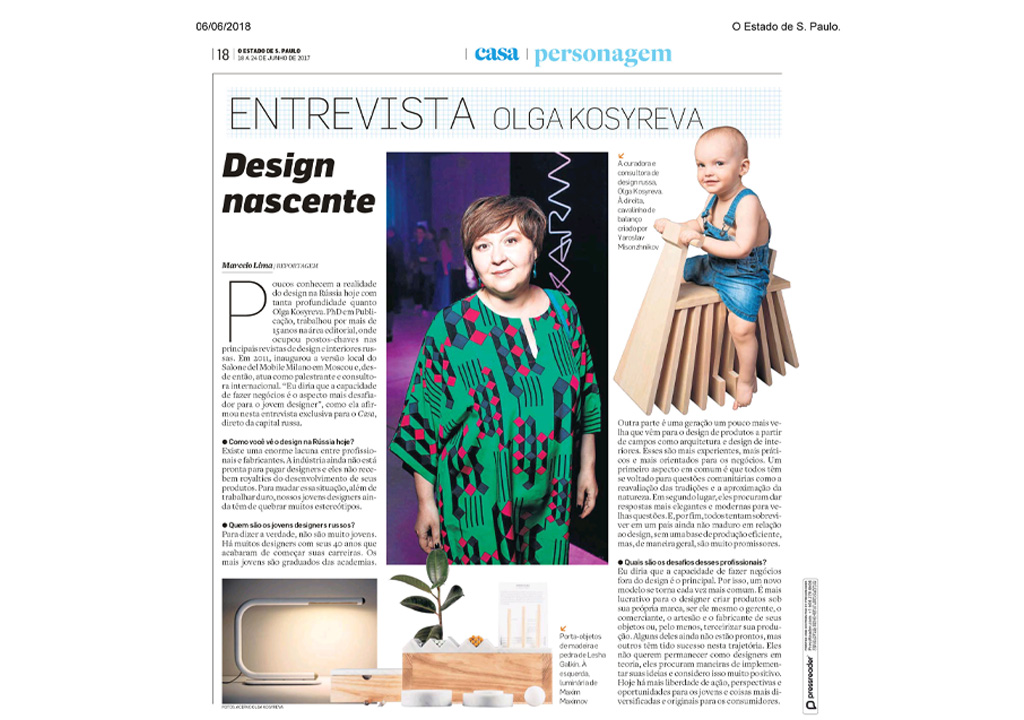"Сейчас главная задача дизайнеров - научиться подходить к дизайну как к бизнесу, с точки зрения экономики, а не чистого творчества. И в этом смысле российский дизайн находится в современном мировом контексте: развиваются мейкерство, селф-продакшн, дизайн-бренды, которые не имеют собственного производства. Современные российские дизайнеры не укладываются в прокрустово ложе пост-советской мебельной индустрии, зато ситуация дает больше свободы действий, перспектив и возможностей, а потребителям дизайна - больше разных оригинальных вещей, изготовленных малым тиражом". Как иллюстрации, в журнале опубликованы работы Maxim Maximov, Yaroslav Misonzhnikov, Лёша Галкин (Lesha Galkin). Также журнал по рекомендации Ольги опубликовал интерьер московской квартиры интерьерного стилиста Наталья Онуфрейчук (Natalia Onufreichuk). "Потому что мне кажется, что это то, чем Москва отличается от других городов мира: тем, что в ней есть советский период истории, и очень здорово, когда это заметно в интерьере", — так считает Ольга Косырева (Olga Kosyreva).
29 Июн 2018
| ПУБЛИКАЦИИ
Интервью с Ольгой Косыревой в бразильском журнале Casa: "Каков современный дизайн в России?"
Published in Casa magazine (Brazil), 6 June 2018
| ПУБЛИКАЦИИ

interview by Marcelo Gomes Lima
In 2009-2010 Olga Kosyreva has worked as Senior Living Editor for Vogue Russia. In 2011 her cooperation with Salone del Mobile Milano has started. There is the Russian version of Salone del Mobile names now Salone del Mobile Milano Moscow. It’s held in Moscow every October for almost 15 years now. As well she has 7 times been a member of Jury at SaloneSatellite Moscow judging the young talents from all over Russia and the countries of its influence (Baltic countries, Ukraine, Belarus, Kazakhstan, Azerbaijan, etc).
— How do you see the design scene in Russia today?
— Well, industrial production of design products in Russia is far from being successful because of the gap between designers and existing production which is huge. The industry is not ready yet to pay designers and they don’t get royalty from the mass-marketed development. To change situation, you need to do the design itself, plus the organization of production, plus sales - so you should work hard and painstakingly, you have to punch the walls, like constant dropping wears away a stone, to break stereotypes.
— Concerning the young Russian furniture designers, in general terms, who are they?
— To tell the truth, they are very different. And not very young indeed, there are a lot of designers in their 40s who just begin their product design carrier. The youngest are the graduates of local Russian design academies and universities trying to make their own way in design. Another part is the other generation (who are about 35-45, so, not very young) and they come to product design from bordered fields like architecture and interior design. And they are more experienced, more practical and more business oriented.
Both generations upvoted top society and design community issues: the preservation and reassessment of traditions, heritage.
— Which are the main questions and concernings of these professionals? Which are their main challenges?
— I would say the ability to make business out of design is the most challenging. Nowadays the new model becoming more and more common. It’s more profitable for the designer to make things under his own brand, to be his own manager, marketer, and a craftsman himself, the manufacturer of his objects, or at least to hire outsource manufacturers for their production. And more and more designers from advanced design countries turn the old model upside down. So inventions of Russian designers are in modern world trends. They don’t want to remain designers in theory, they’re looking for ways to implement their ideas. Most of the items are made in small batches from skilled craftsmen. They do not fit into the Procrustean bed production machine, what is normally out of date and too awkward. And this fact might be for the best. Situation of now gives more freedom of action, prospects and opportunities to youngsters and more diverse and original things for design consumers.












